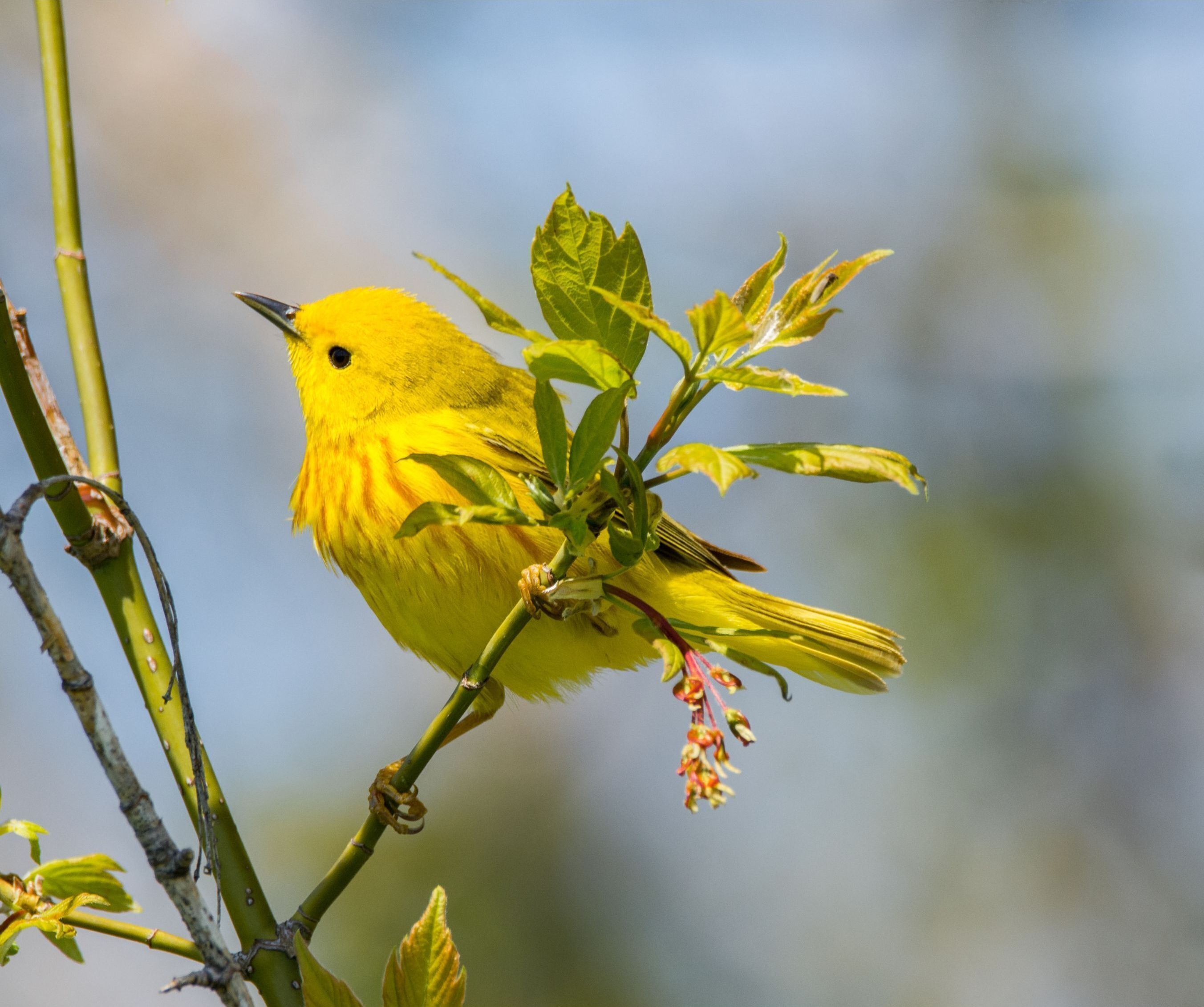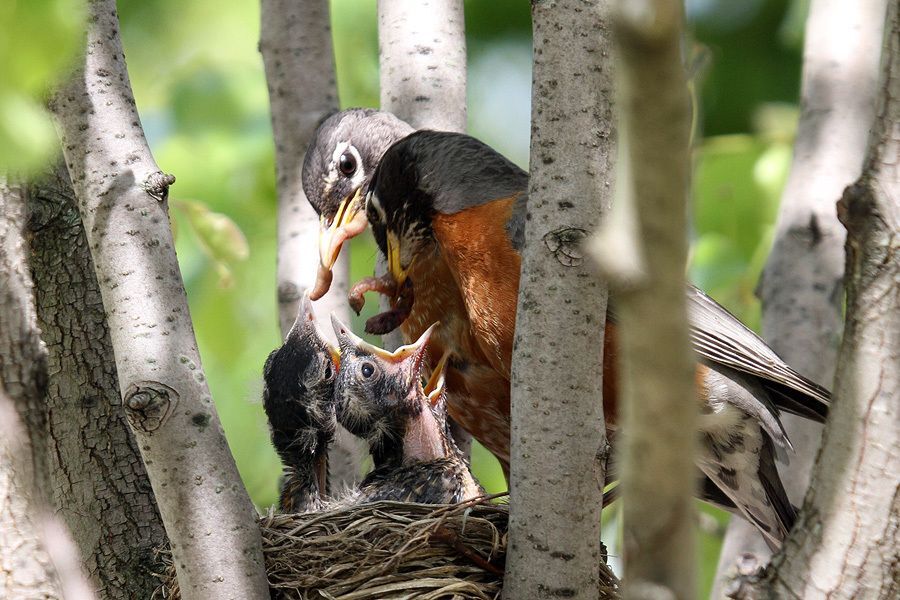
Published March 26, 2024
To Be a Bird Is Not What You Think
By Dr. Charles Clarkson, Director of Avian Research
Pretend for a moment that you are a bird. More specifically, pretend that you are a male Yellow Warbler, the most common species of warbler in Rhode Island.
Let’s assume you have overwintered in the central lowland rain-forests of Panama. While you moved about, you have been keeping an eye out for predators of all kinds looking to make you a snack…hawks, falcons, snakes, bats, cats and the like. And…while you’ve been eating and vigilant, you’ve also been molting your flight and body feathers, a process that is energetically costly but necessary for the upcoming migration and breeding season.
Finally, when the time has come to migrate north and breed, you fatten up over several weeks, beginning your trip with a non-stop flight over the Gulf of Mexico, a journey of roughly 800 miles with just the fat stores in your body and your muscles powering your wings. Once you reach the shores of the U.S., you drop from the sky and search frantically for enough fuel to replace some of what was used and provide for the next leg of your journey. Again, you go to work searching high and low for insects and spiders…as many as you can find, as quickly as you can find them. You are being compelled to continuously move by two major forces: the first to avoid the suite of predatory animals that have planned for your arrival and the second impulse to get back to Rhode Island as quickly as possible. The earliest birds to arrive in the Ocean State get the best territories, the first mating opportunities, and the ability to nest quickly and re-nest if necessary.
Getting to Rhode Island first means everything.
Over the next few days, you monitor the climate and when conditions are right, under the cloak of darkness you continue your journey. You will repeat this process…migrating all night, stopping during the day to refuel, migrating again, until you reach your breeding site…a shrubby area along the Wood River in western Rhode Island. No time is wasted. You scout the best territory…perhaps it was the same one you occupied last year. Your time is now spent defending the territory in earnest as new males arrive and attempt to usurp your spot, and you sing from every perch in every corner of your defended area. When females begin arriving, you have to split your attention between attracting the eye of a potential mate and continuing to defend your territory from rival males. Fights and chasing ensues. Some of your neighbors spend so much time fighting that they fail to see the Cooper’s Hawk that swoops in or the cat hidden under a bush. Their life ends abruptly. Yours continues…for as long as you remain vigilant.
Your fledglings enter the most dangerous period of their lives.
You did it. Your chicks have fledged! Well, what’s left of them. You lost one chick…eaten in the night, but the rest have survived. Now, your three nestlings are suddenly fledglings and you must accompany them for 20 days as they learn to forage on their own. This is the most dangerous part of their life, with mortality rates skyrocketing. It’s not hard to understand why…the fledglings barely know how to fly, they need to learn how to feed themselves, they are not entirely sure what creatures are friend or foe and their reaction time is slow. It is now mid-July. By mid-August you will begin your south-bound migration… time is of the essence.
You lead your fledges through new habitats and expose yourself and your family to all sorts of new threats. You begin to molt, a complete replacement of all your feathers, while your fledges initiate their own molt, replacing many of their feathers as well. This increases your energetic needs. Eat, eat, eat. Eat some more. During this time, you and your fledges will also need to pack on some additional grams of mass for the upcoming migration, so…DON’T. STOP. EATING.
Mid-August arrives quickly. You managed to keep one of your fledges alive. One was taken out by a house cat, the other run over by a car. With just one surviving fledge, you’ve done nothing to contribute to the growth of your population this year…you will have to try again if you survive. You depart on your southbound migration, leaving your recent fledge and mate behind. They will need to figure things out for themselves.
The non-stop journey across the Gulf of Mexico lies ahead.
You fly south. Stopping only to refuel and rest, keeping yourself alive. Now, the biggest hurdle, the nonstop voyage across the Gulf of Mexico, lies at the very end of your travels. A final slap in the face after working so hard for so long. But, with determination, experience, superior genetics, and an amazing evolutionary history that has shaped you for this very journey, you make it unscathed. As the morning light begins to brighten the horizon, you see Panama ahead…only a few more miles.
You’ve done it. With any luck, you might live for 6 or 7 years. You will complete this cycle many more times. But for now the insects are ripe for the plucking…just don’t forget about all the predators.
OK, you can now stop pretending you are a bird.
Being a bird is not easy. It is not peaceful. It is easy for us to derive peace from looking at birds. They seem graceful and beautiful. But their work is nonstop, and their lives are tough. The very least we can do to ensure their success is to make their jobs as easy as possible…by protecting habitats and resources critical to their needs.
When we help birds survive, we help each other. Learn more about the Audubon Avian Research Initiative. Visit asri.org/AvianResearchInitiative.


















